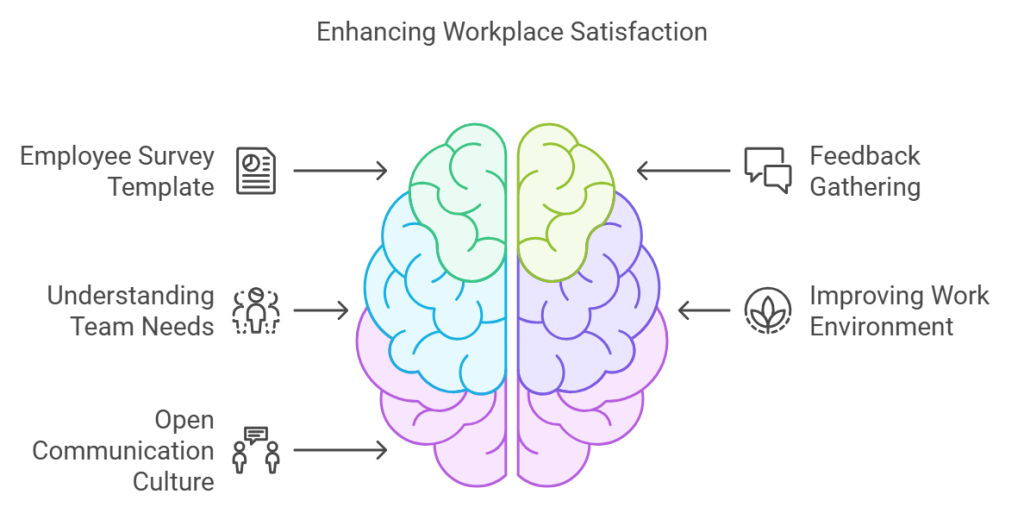
Discover the perfect employee survey email template! Boost engagement, gather valuable feedback, and make informed decisions with ease.
Creating a positive workplace environment is essential for employee satisfaction and productivity. One effective way to gauge employee sentiment and gather valuable feedback is through employee surveys.
By understanding your team’s needs and concerns, you can make informed decisions that enhance their work experience. In this blog, we will discuss the importance of employee surveys, common pain points faced by employees, and provide a comprehensive email template to help you conduct an effective survey.
Why Employee Surveys Matter
Employee surveys serve as a vital tool for organizations to collect insights on various aspects of the workplace, including job satisfaction, communication, and company culture. Here are some key reasons why conducting regular surveys is crucial:
Identifying Issues: Surveys help uncover underlying problems that may not be apparent in day-to-day interactions. Employees may feel hesitant to voice concerns directly, but anonymous surveys provide a safe space for honest feedback.
Enhancing Engagement: When employees feel heard and valued, their engagement levels increase. Surveys demonstrate that management cares about their opinions, fostering a sense of belonging.
Driving Change: The feedback gathered from surveys can inform strategic decisions that lead to meaningful changes within the organization. This may include adjustments to policies, workplace conditions, or team dynamics.
Common Pain Points in the Workplace
Understanding the common challenges faced by employees can help you tailor your survey questions effectively. Here are some prevalent pain points:
Lack of Communication: Employees often report feeling disconnected from management and their peers due to insufficient communication channels.
Workload Stress: Many employees experience stress from heavy workloads and tight deadlines, leading to burnout.
Career Development Opportunities: Employees may feel stagnant in their roles if they perceive a lack of growth opportunities within the organization.
Recognition and Appreciation: A lack of recognition for hard work can demotivate employees, making them feel undervalued.
Crafting an Effective Employee Survey Email
To maximize participation and gather meaningful insights, it’s essential to craft a well-structured survey email. Below is a template that you can customize for your organization:
Employee Survey Email Template
Subject Line: Your Feedback is Important – Please Participate in Our Employee Survey!
Email Body:
Hello Team,
I hope this message finds you well! At [Company Name], we are committed to creating a positive work environment where everyone feels valued and heard. To achieve this, we need your help.
We are conducting an employee survey aimed at gathering your thoughts and experiences regarding various aspects of our workplace. Your feedback is crucial in helping us identify areas where we can improve and enhance your experience at [Company Name].
Key Details:
Purpose: To understand your perspectives on job satisfaction, communication, workload, and overall workplace culture.
Confidentiality: Rest assured that all responses will be kept confidential and will only be used for internal improvement purposes.
Time Commitment: The survey should take approximately [X minutes] to complete.
Incentive: As a token of appreciation for your participation, all respondents will be entered into a draw to win [insert prize or incentive].
How to Participate:
Please click the link below to access the survey:
[Insert Survey Link]Your input is invaluable to us! We genuinely appreciate your time and insights. If you have any questions or concerns regarding the survey, feel free to reach out to me directly.
Thank you for being an essential part of our team!
Best regards,
[Your Name] [Your Position] [Company Name]You Must Know
Top E-Survey Apps: Quick Data Collection on the Go
Supercharge Your Sales: Unbeatable Lead Survey to Boost Conversions
Best Practices for Survey Success
To ensure high participation rates and meaningful feedback from your employee survey, consider the following best practices:
1. Timing Matters: Choose an appropriate time to send out your survey when employees are less likely to be overwhelmed with deadlines or projects.
2. Keep It Short: Aim for brevity in your survey questions to respect employees’ time while ensuring you gather necessary information.
3. Follow Up: Send a reminder email a few days before the survey deadline to encourage those who haven’t participated yet.
4. Communicate Results: After collecting responses, share key findings with your team and outline any actions you’ll take based on their feedback. This transparency builds trust and encourages future participation.
5. Regular Check-ins: Conduct surveys regularly (e.g., annually or biannually) to track changes in employee sentiment over time.
Conclusion: Employee Survey Email Template
Conducting employee surveys is an effective way to boost workplace satisfaction by addressing employees’ needs and concerns. By implementing the email template provided above and following best practices, you can create an environment where employees feel valued and engaged. Remember that the ultimate goal is not just collecting feedback but also acting on it to foster a positive workplace culture that benefits everyone involved.
By prioritizing employee satisfaction through regular feedback mechanisms like surveys, organizations can cultivate a thriving workplace where both employees and the business can succeed together.

